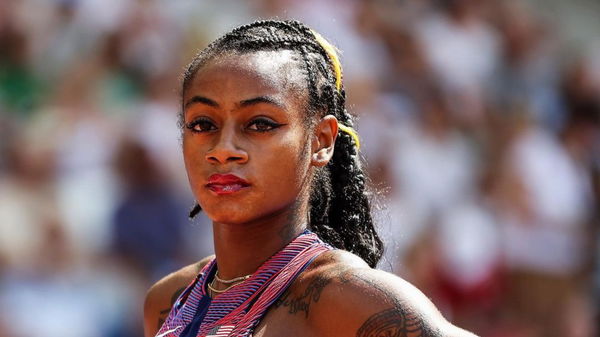

When Citius Mag dropped the first look at Team USA’s outfits for the 2024 Paris Olympics on April 11th, the women’s attire captured the spotlight. Critics condemned the high-cut leotard design, accusing the brand of sexism, and questioned the involvement of any female athletes in the creative process. Athletes like Tara Davis-Woodhall and Lauren Fleshman publicly rejected the uniforms.
Countries like Germany designed full-length bodysuits for women gymnasts for the Tokyo Olympics earlier and New Zealand updated their rules to allow female athletes to wear leggings or shorts over the leotards as a stand against sexualization in the sport. The burning question now is: What’s next for Team USA’s wardrobe?
Adding to the list of queries: Will the athletes ultimately have the final say in their Parisian attire? Or does Nike have other plans, too? To answer all, Nike assured CNN in a statement that the controversial leotard design unveiled recently is just one of several styles available for athletes to choose from, with additional tailoring options to be provided for the upcoming Olympic Games.
ADVERTISEMENT
Article continues below this ad
The sportswear giant emphasized its commitment to meeting athletes’ needs, as expressed through a collaborative design process. According to a press release issued by Nike last week, the company highlighted its close collaboration with athletes at every stage of development. John Hoke, Nike’s Chief Innovation Officer, reiterated this approach and stated that garments were meticulously crafted to cater to various body types and style preferences, incorporating real-time feedback throughout the design cycle.
BREAKING: Here's your first look at the new @Nike kits that will be worn by the U.S. track and field team at the 2024 Olympics in Paris. pic.twitter.com/XPWOnBrwsv
— CITIUS MAG (@CitiusMag) April 11, 2024
Echoing this sentiment, a spokesperson for USA Track and Field (USATF) informed CNN that the outfits showcased during the launch were just a fraction of the extensive range available, boasting over 50 unique pieces and 12 competition styles for specific events. They also mentioned that the leotard was offered with options of briefs and shorts. USATF emphasized that athlete input was paramount in the planning process, with Nike consulting athletes to ensure both comfort and functionality across different events.
Despite the efforts, it appears that even some of the athletes who modeled the Nike-designed outfits were not entirely comfortable with them.
Athletes challenge norms: Sha’Carri Richardson and Anna Cockrell lead the way
Sha’Carri Richardson, the reigning 100m world champion, made a striking appearance at Nike’s high-profile launch event in Paris on Thursday. However, her participation took an unexpected turn as she diverged from the typical attire expected of athletes modeling the brand’s latest creations. Richardson opted for shorts instead of the traditional leotard, a deviation echoed by fellow athlete Anna Cockrell, who sported briefs during the show.
These choices sent a clear message: the athletes communicated discomfort with the standard attire. Richardson’s decision to forego the leotard, along with Cockrell’s choice, sparked a broader conversation within the athletic community. Former US national 5,000m champion Lauren Fleshman took to Instagram to condemn the design, arguing that such attire subjected female athletes to unnecessary distractions and scrutiny.
Fleshman criticized the outfit as ill-suited for competitive performance, highlighting the burdensome expectations placed on women in sports. Joining the chorus of dissent, US long-jumper Tara Davis-Woodhall expressed bemusement at the attire’s revealing nature. Responding to a social media post showcasing the designs, Davis-Woodhall humorously pointed out athletes’ discomfort and vulnerability in such revealing outfits. Even US middle-distance runner, Colleen Quigley had a similar opinion on the high-cut leotard design.

via Getty
BUDAPEST, HUNGARY: August 25: Sha’Carri Richardson of the United States after her bronze medal win in the Women’s 200m Final during the World Athletics Championships, at the National Athletics Centre on August 25th, 2023 in Budapest, Hungary. (Photo by Tim Clayton/Corbis via Getty Images)
Reigning Olympic pole vault champion Katie Moon entered the fray, offering a contrasting perspective on the debate surrounding athletic uniforms. In a statement on Instagram, Moon, who Nike sponsors, pushed back against the notion that attire choices were inherently sexist. She expressed, “Whether we feel best in a potato sack or a bathing suit during competitions, we should support autonomy.” Yet, it holds some truth. Athletes should have the freedom to wear comfortable clothes of their choice, as few athletes have rightly pointed out.
Ultimately, whether athletes opt for briefs, leotards, or any other attire, the decision should be entirely theirs. After all, the athletes must perform and strive for victory, and their comfort should never be compromised. Their autonomy is paramount. It will be intriguing to witness whether athletes assert their personal preferences in attire if Nike continues to craft superior outfits tailored to their needs or if they choose from among the fifty other options available.
ADVERTISEMENT
Article continues below this ad
ADVERTISEMENT
Article continues below this ad
ADVERTISEMENT
ADVERTISEMENT
ADVERTISEMENT
ADVERTISEMENT

